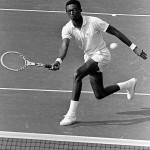Arthur Ashe is one of the finest athletes Virginia ever produced and is well known for his work in social and social justice. There have been been many books written about him, including his autobiography, but here’s one of the latest, written by a professor at Georgia Southern University. Here’s a book review I did for Style Weekly:
The Life magazine cover photo from Sept. 20, 1968, nails it.
In traditional tennis whites contrasting against his dark skin stands a lean, intense, Richmond-born athlete at the net clutching a tennis racket. The headline reads: “He topped the tennis world. The Icy Elegance of Arthur Ashe.”
Ashe was all that and more. He spent his childhood hitting the ball about segregated Brook Field Park in Richmond’s North Side and endured decades of racism at home and abroad. By 1968, he was using his vicious backhand and killer serve — 26 aces in one match — to become the first black player to win the U.S. Open. It was just one rung on a marvelous tennis career in a sport that had been almost completely closed to members of his race.
Ashe was anything but conventional. His father, Arthur Sr., was a strict disciplinarian who taught him courtesy and responsibility. As a gentlemanly young player in the 1950s, he quietly endured insults from the likes of the Country Club of Virginia, where he was unwelcome to play in city tournaments. He ended up working the all-black American Tennis Association circuit before finally escaping Richmond’s racism to St. Louis and then the University of California at Los Angeles, where he emerged as a top U.S. Davis Cup team member.
Along the way, he slowly developed a sense of social justice that burned in him until his death in 1993 from AIDS, which he acquired in a blood transfusion during heart surgery. Ashe’s rise as an activist against racism is well documented in Eric Allen Hall’s new book, “Arthur Ashe: Tennis and Justice in the Civil Rights Era,” (Johns Hopkins University Press). It should be of special interest locally, with Ashe’s statue standing in marked contrast just down Monument Avenue from the Confederate generals.
To read more, click here:



